Abstract
This study investigates the combined use of recycled concrete aggregate (RCA) and steel fibers—industrial (ISF), recycled (RSF), and hybrid ISF/RSF (HSF)—to enhance the mechanical performance, freeze–thaw durability, and environmental efficiency of roller-compacted concrete pavement (RCCP). Twenty mixtures incorporating two RCA levels (0% and 25%) and different fiber systems were tested. The results showed that, although RCA slightly reduced strength, hybrid fibers effectively compensated for this loss, improving toughness, tensile capacity, and resistance to freeze–thaw degradation. A life-cycle assessment demonstrated that substituting natural aggregates and industrial fibers with RCA and RSF lowers the embodied carbon and energy demand. A multi-criteria decision analysis identified mixtures with 25% RCA and hybrid fibers (0.9% HSF) as the most balanced solutions, combining an improved performance with a reduced environmental burden. The findings highlight hybrid fiber-reinforced, RCA-based RCCP as a practical and eco-efficient option for sustainable pavement infrastructure.
1. Introduction
The construction sector is a major driver of global environmental impacts, responsible for over one-third of natural resource consumption, energy use, and greenhouse gas (GHG) emissions [,,]. Within this sector, concrete infrastructure contributes substantially to embodied carbon and resource depletion due to the intensive use of virgin aggregates, cement, and industrial additives [,,]. As sustainability becomes a core objective in civil infrastructure, reducing the environmental footprint of concrete pavement systems without compromising mechanical performance or durability has become imperative [,].
Roller-compacted concrete pavement (RCCP) has gained attention as a more sustainable alternative to conventional pavements, owing to its lower cement content, reduced water usage, and rapid, heavy-compaction placement. RCCP is widely employed in industrial, highway, and airfield settings for its structural efficiency and cost-effectiveness [,]. However, conventional RCCP depends heavily on virgin natural aggregates (NAs) and industrial steel fibers (ISFs), both of which carry high energy and GHG burdens in production and transport [,]. Enhancing RCCP eco-efficiency therefore requires integrating recycled constituents that lower impacts while preserving structural integrity [].
Incorporating recycled concrete aggregates (RCAs) sourced from construction and demolition waste is a promising pathway. RCA use aids waste reduction, landfill diversion, and the conservation of primary resources, aligning with circular economy objectives [,,]. Nonetheless, RCA can degrade mechanical performance—commonly reducing compressive and tensile strengths and freeze–thaw resistance—because of its higher porosity and weaker interfacial transition zones [,,].
Fiber reinforcement is a common mitigation strategy. ISFs are effective at improving tensile, flexural, and post-cracking behavior [,,,], but their manufacturing footprint raises environmental concerns. Recycled steel fibers (RSFs), recovered from end-of-life tires or industrial scrap, offer a lower-cost, lower-carbon option with substantial mechanical potential [,,]. RSFs have been shown to enhance crack control, toughness, and energy absorption, although their performance depends on dosage and dispersion quality [,].
Recent evidence indicates that hybrid steel fiber (HSF) systems, combining ISFs and RSFs, can yield synergistic responses superior to single-fiber mixes [,]. In such systems, ISFs contribute stiffness and load-carrying capacity, while RSFs improve ductility and multidirectional crack control via their irregular geometry []. Together, these fibers can offset the mechanical deficits introduced by RCAs and bolster resistance to freeze–thaw deterioration. The underlying mechanism involves multi-scale crack stabilization: RSFs bridge micro-cracks, and ISFs resist macro-crack growth and enhance pull-out performance, producing behavior that surpasses either fiber used alone [,]. Despite these advantages, comprehensive studies on RCCP that jointly evaluate RCA and HSF, particularly with respect to freeze–thaw durability and life-cycle environmental performance, remain limited [,,]. Furthermore, few investigations employ multi-criteria decision analysis (MCDA) to balance performance and sustainability when identifying optimal mixtures [,,].
However, several critical research gaps remain unaddressed. Most existing RCCP studies evaluate recycled aggregates or steel fibers individually, without exploring their combined effects on mechanical behavior, freeze–thaw durability, and environmental performance. Hybrid steel fiber systems (ISFs + RSFs) have been scarcely investigated in RCCP, particularly under extended freeze–thaw cycling, and their potential to mitigate RCA-induced weaknesses remains insufficiently understood. In addition, no prior work integrates mechanical testing, durability evaluation, and cradle-to-gate life-cycle assessment (LCA) within a single unified framework or employs entropy-weighted MCDA to determine eco-efficient RCCP mixtures.
Addressing these gaps, the present study proposes a comprehensive experimental–environmental framework that evaluates 20 RCCP mixtures incorporating RCA and hybrid steel fibers and identifies optimal mixtures using combined LCA and MCDA. This integrated methodology—linking hybrid fiber synergy, RCA utilization, freeze–thaw resistance, and environmental efficiency—constitutes a novel contribution to the existing RCCP and hybrid fiber literature. A concise conceptual diagram (Figure 1) is included to illustrate the research workflow and highlight the study’s originality.
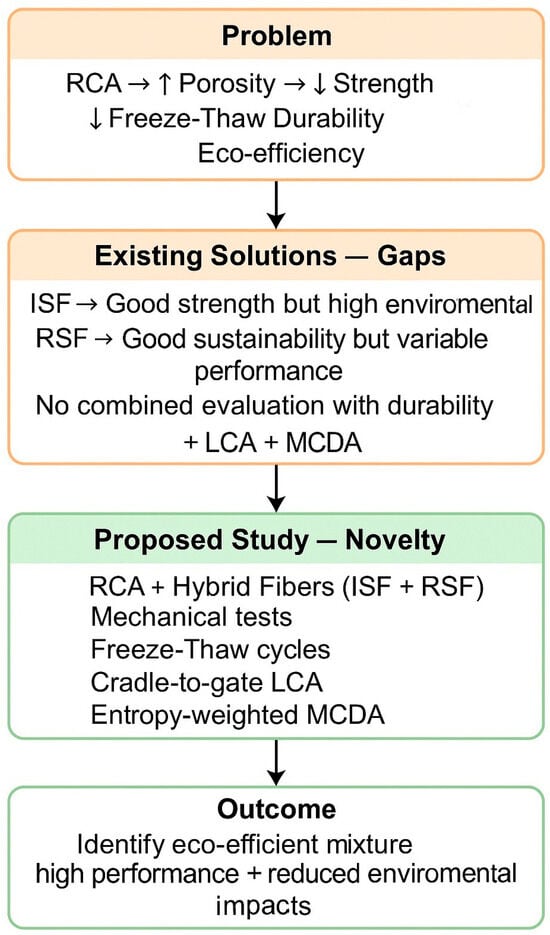
Figure 1.
Conceptual diagram summarizing research gaps, proposed methodology, and expected outcomes of the study.
To test this hypothesis, this study examines the combined effects of RCA content (0–25% by volume) and fiber type/dosage (ISFs, RSFs, and HSFs at 0–0.9% by volume fraction) on the mechanical performance, freeze–thaw resistance, and life-cycle environmental impacts of RCCP. Twenty RCCP mixtures were produced and tested in compression, splitting tension, and flexure, and were subjected to freeze–thaw exposure for 100, 200, and 300 cycles. Environmental impacts were quantified via a cradle-to-gate LCA across nine categories. Finally, MCDA using the Weighted Sum Method (WSM) and TOPSIS was implemented to identify the most eco-efficient mixture. Overall, the study delivers an integrated experimental–environmental framework for sustainable RCCP design using waste-derived aggregates and fibers, advancing cleaner production, resource circularity, and low-carbon pavement infrastructure.
2. Materials and Methods
To provide a clear overview of the methodological workflow adopted in this study, a schematic of the integrated experimental LCA-MCDA framework is presented in Figure 2. The diagram presents the main steps of the study. First, the RCCP mixtures were designed. Then, mechanical tests were performed, including compressive strength, splitting tensile strength, and flexural tensile strength. Freeze–thaw durability was evaluated using strength retention indices, compressive strength retention (CSR), tensile strength retention (TSR), and flexural strength retention (FSR), for 100–300 cycles. A cradle-to-gate LCA was then carried out. The assessment covered global warming potential (GWP), ozone depletion potential (ODP), acidification potential (AP), eutrophication potential (EP), photochemical ozone creation potential (POCP), abiotic depletion for elements and fossil resources (ADP-elements, ADP-fossil), and primary energy demand (renewable and non-renewable) (PE-Re, PE-NRe). Finally, an entropy-weighted MCDA was applied using the WSM and TOPSIS. This framework ensures that mechanical, durability, and environmental results are interpreted together in a consistent way.
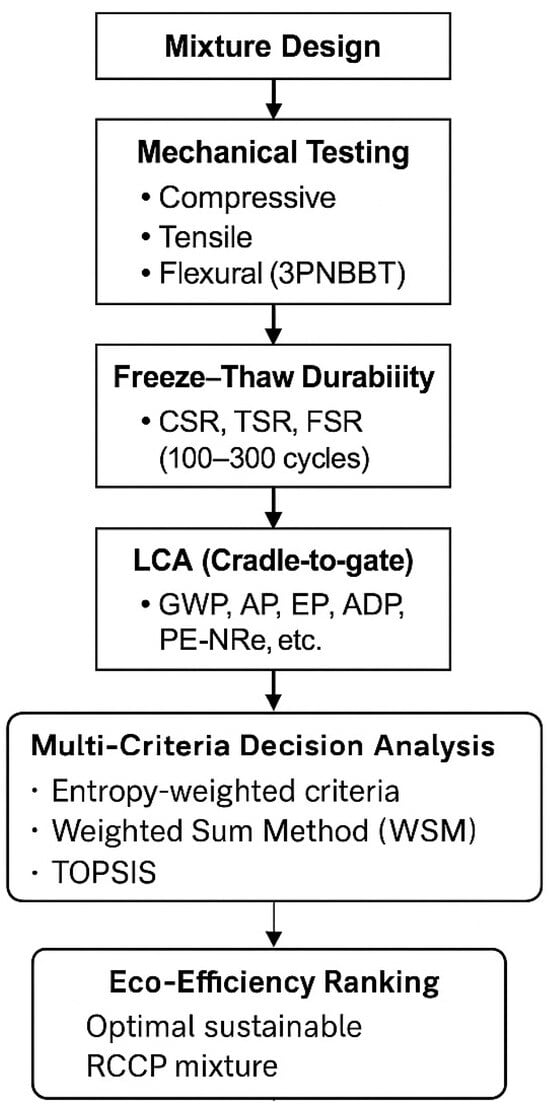
Figure 2.
Integrated experimental LCA-MCDA framework used to evaluate and rank RCCP mixtures.
Twenty RCCP mixtures were prepared and divided into two series, representing 0% and 25% RCA replacement (by mass). Each series consisted of ten mixtures: a plain control, ISF-only and RSF-only mixtures at 0.3%, 0.6%, and 0.9% fiber contents, and hybrid mixtures with equal ISF and RSF proportions at equivalent total fiber dosages.
Mix identifiers follow the convention N100_R0_ISF0.3_RSF0, where “N100” and “R0” denote 100% NA and 0% RCA, respectively, and the trailing fields specify the fiber dosages. This coding scheme was used consistently in the mixture design table and throughout the presentation of results.
Mechanical performance at 28 days and freeze–thaw durability (100, 200, and 300 cycles) were assessed using four replicate specimens for each data point. Results are reported as mean values with corresponding coefficients of variation (CoVs). Outlier detection was performed using Grubbs’ test, Dixon’s Q test, and boxplot analysis, and outliers were removed where justified. In all figures, error bars indicate variability, and CoV (%) values are shown in parentheses.
2.1. Materials
2.1.1. Aggregates
Coarse and fine aggregates were selected in accordance with ACI 211.3R and ACI 325.10R, and their physical–mechanical properties were determined following the relevant ASTM standards to ensure compliance with RCCP requirements. The RCA (4.76–23.00 mm) was produced by crushing previously tested OPC concrete cylinders (≈40 MPa) and subsequently conditioned through manual re-crushing, washing, filtering, and sieving to remove fines and contaminants. The natural aggregates comprised crushed granite (CG; 4.76–22.50 mm) and river sand (RS; 0–4.76 mm). The particle-size distribution curves for the N100_R0 and N75_R25 series are presented in Figure 3, with all gradations falling within ACI 211.3R limits, indicating well-graded aggregates suitable for high-density RCCP.

Figure 3.
Particle size distribution curves of the combined aggregates used in the two RCCP series: (a) N100_R0 and (b) N75_R25.
Aggregate properties were determined according to ASTM C127/C128 (specific gravity and absorption), ASTM C29 (bulk density and voids), ASTM C136 (sieve analysis), and ASTM C117 (fines content). Additionally, geometric and mechanical indices, including the flakiness index (EN 933-3), elongation index (EN 933-4), and aggregate crushing value (ACV, BS 812-110), were measured for coarse aggregates. These tests apply only to particles retained on coarse sieves; therefore, values for river sand (fine aggregate) are reported as not applicable (N/A). The combined physical, geometric, and mechanical characteristics of CG, RCA, and RS are presented in Table 1.

Table 1.
Physical, geometric, and mechanical properties of the natural and recycled aggregates used in the RCCP mixtures.
2.1.2. Cement, Water, and Admixture
The binder employed was ordinary Portland cement (CEM I 42.5R), compliant with EN 197-1. Its oxide composition is reported in Table 2. Compressive strengths of 20 MPa at 2 days and 42.5 MPa at 28 days verified its high early strength classification. The cement was locally supplied and stored in temperature-controlled, low-humidity conditions to prevent prehydration. Its specific gravity was 3.18 g/cm3. Potable water free of organic contaminants and compliant with ASTM C1602 was used for batching and curing.

Table 2.
Chemical composition of cement (CEM I 42.5R) by weight percentage.
A polycarboxylate–ether superplasticizer (Master Glenium SKY 617, BASF, Lisbon, Portugal) was incorporated at 3.4–10.2 kg/m3 to achieve the required workability, particularly for mixtures with reduced water content and higher fiber volumes.
2.1.3. Fibers
To enhance mechanical response, durability, and sustainability, two steel fiber types were employed: industrial steel fibers (ISFs) and recycled steel fibers (RSFs). Their appearances and the measured RSF geometry distributions are shown in Figure 4. ISFs were commercially manufactured, hooked-end fibers with a nominal length of 33 mm, commonly used in structural concrete for their consistent geometry and established performance. RSFs were recovered from end-of-life tires via mechanical shredding, contributing to waste valorization and circular economy aims. Owing to their recovery process, RSFs exhibited irregular geometry and nonuniform dimensions (length and diameter). To obtain representative metrics, the RSF morphology was statistically characterized using a sample of 3000 fibers, and the resulting length and diameter distributions are presented in Figure 4c,d. The measured RSF geometry yielded an average length of 26 ± 10 mm and a diameter of 0.25 ± 0.08 mm, reflecting the inherent variability of tire-derived fibers. Using RSFs offers a pathway to lowering impacts associated with virgin steel production and tire disposal. Key physical and mechanical properties of both fiber types are summarized in Table 3.
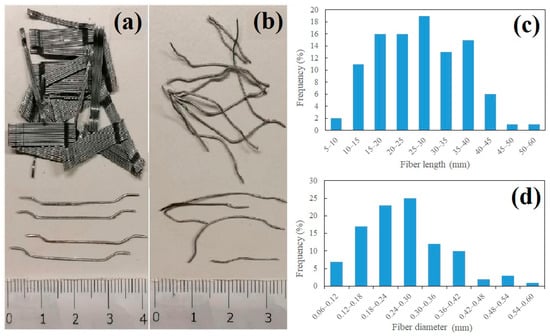
Figure 4.
Fibers used in fiber-reinforced RCCP mixtures: (a) uniform hooked-end ISF; (b) irregular tire-derived RSFs; (c) RSF length distribution; and (d) RSF diameter distribution.

Table 3.
Physical and mechanical characteristics of industrial and recycled steel fibers.
A detailed description of the fiber configuration is also provided to improve clarity. ISFs consist of straight hooked-end macrofibers (aspect ratio ≈ 55), while RSFs are twisted, irregular steel cords that tend to orient randomly and interlock within the matrix. Hybrid mixtures used a 50:50 volumetric ratio of ISFs and RSFs to combine macro-crack-bridging (ISFs) with multidirectional micro-crack control (RSFs).
The selected fiber dosages (0.3%, 0.6%, 0.9%) fall within the commonly recommended range for pavement-grade steel fiber concretes (0.3–1.0%), ensuring workable RCCP mixes while producing measurable improvements in strength and toughness [,]. The ISF length of 33 mm corresponds to a standard hooked-end macrofiber widely adopted in concrete applications. The 50:50 hybrid ratio (ISF:RSF) was adopted based on recent findings showing that balanced hybridization enhances crack-bridging efficiency and improves post-cracking behavior in fiber-reinforced concrete [].
2.2. Methods
2.2.1. Mixture Design and Specimen Preparation
Twenty RCCP mixtures were proportioned following ACI 211.1-91. Each series contained ten mixes, including a plain control (0% ISF, 0% RSF). Compaction parameters were established using the Modified Proctor procedure (ASTM D1557) to determine the optimum moisture content (OMC) and corresponding maximum dry density (MDD). Water content was incrementally adjusted, and the OMC was taken at the observed MDD. Mixture quantities per cubic meter and the resulting water-to-cement ratio (Wat/Cem) were calculated on the basis of the OMC. A detailed listing of the complete mix proportions for all 20 RCCP mixtures is provided in the Supplementary Materials (Table S1), while Table 4 presents a concise summary of the key mixture variables used in this study.

Table 4.
Summary of RCCP mixture variables used in the experimental program.
The maximum RCA replacement level was limited to 25% based on recent evidence indicating that RCA contents above 25–30% often lead to notable reductions in mechanical strength and durability; therefore, 25% represents a practical upper bound to balance performance and sustainability requirements [,].
Dry constituents (cement and aggregates) were mixed for 1 min. Fibers were then introduced gradually, followed by water and superplasticizer (SP), to promote uniform dispersion and minimize balling. Mixing continued for an additional 5 min to achieve homogeneity. Fresh RCCP was placed in cylindrical molds (150 × 300 mm) and prismatic molds (150 × 150 × 600 mm) for mechanical and durability testing. Compaction was performed using an electric vibrating hammer in line with ASTM C1435, applying three layers per specimen. Each layer was compacted for up to 20 s or until the formation of a continuous mortar ring indicated adequate consolidation. Specimens were demolded after 24 h and water-cured at 23 ± 2 °C for 28 days in accordance with ASTM C192/C192M.
2.2.2. Mechanical Test Procedures
The mechanical performance of RCCP was assessed via uniaxial compressive strength, splitting tensile strength, and three-point notched beam bending tests (3PNBBT), following the relevant standards to ensure accuracy and repeatability. After 28 days of curing, the compressive strength and secant modulus of elasticity were determined in accordance with NP EN 12390-3:2011 and NP EN 12390-13:2014, respectively. Tests were performed on 150 mm × 300 mm cylinders using a servo-controlled universal testing machine (capacity: 2000 kN). Axial displacement was monitored with an internal displacement transducer used as the control variable during loading. Compressive strength was computed from the peak load, and was obtained from the slope of the linear portion of the stress–strain response. Compressive toughness, , the area under the stress–displacement curve up to one-third of the peak compressive strength, was used to quantify energy absorption [,,]. The setup and instrumentation are shown in Figure 5.
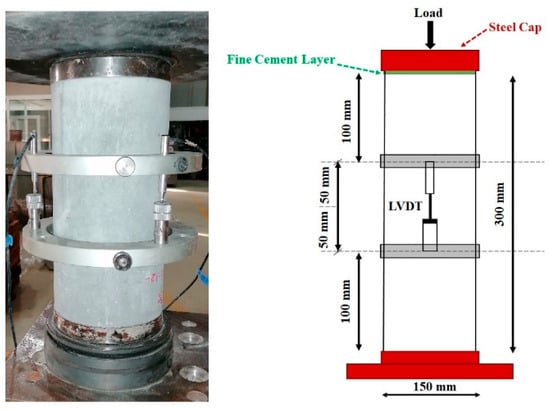
Figure 5.
Experimental setup and monitoring for uniaxial compression: photo and front views.
Splitting tensile strength was measured per ASTM C496/C496M on 150 mm × 300 mm cylinders (Figure 6). Specimens were loaded diametrically between hardened steel bearing strips under compressive load. Transverse deformation, recorded perpendicular to the loading axis, characterized the indirect tensile response. The peak load from the load–deformation curve was used to compute using Equation (1), where D and L are the specimen diameter and length:
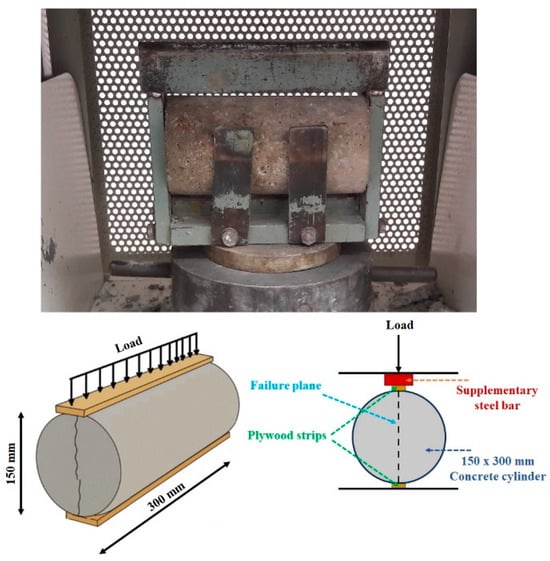
Figure 6.
Splitting tensile test arrangement: isometric, front, and in-test photographs.
Flexural behavior was evaluated using 3PNBBT in accordance with the fib Model Code 2010. Prismatic specimens (150 × 150 × 600 mm) with a 500 mm span incorporated a mid-span notch 25 mm deep (<5 mm wide) to promote controlled crack initiation. Tests were conducted under monotonic loading using a 250 kN servo-hydraulic actuator. The initial flexural tensile strength was taken at a crack-mouth opening displacement (CMOD) of 0.05 mm. Residual flexural strengths () were determined at CMODs of 0.5, 1.5, 2.5, and 3.5 mm, respectively. Continuous load–CMOD acquisition enabled the evaluation of post-cracking performance. Flexural toughness was calculated as the area under the load–CMOD curve up to 3.5 mm CMOD. Fracture energy was computed as the same area normalized by the fracture surface. The test setup and monitoring system are shown in Figure 7.
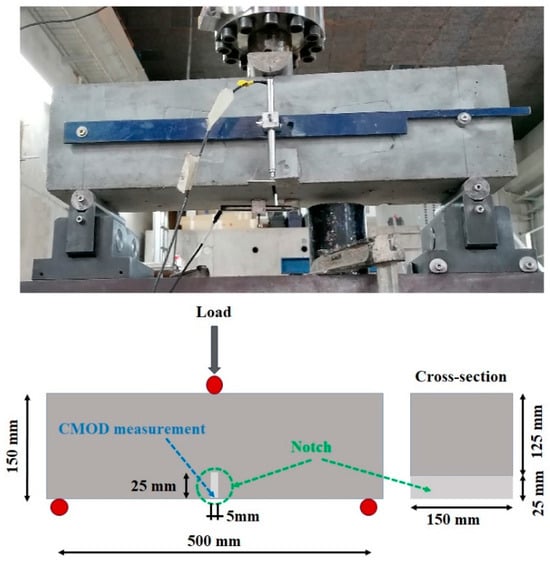
Figure 7.
Three-point notched beam bending (3PNBBT): photo, front, and cross-section views.
2.2.3. Durability Testing
Freeze–thaw resistance was evaluated following ASTM C666 Procedure A. Specimens were water-saturated for 24 h and then cycled in a climatic chamber. Each freeze–thaw cycle followed the profile in Figure 8b: cooling from +18 °C to −18 ± 2 °C, holding at −18 °C, and thawing back to +18 ± 2 °C. One full cycle lasted about 6 h. Specimens remained submerged in water at all times. After each interval, residual compressive strength (NP EN 12390-3:2011), splitting tensile strength (ASTM C496/C496M), and flexural tensile strength (fib Model Code 2010) were measured. Strength retention ratios were obtained by normalizing degraded values to corresponding reference specimens cured under ASTM C192/C192M conditions. Schematics of the climatic chamber and the thermal profile of a representative freeze–thaw cycle are shown in Figure 8.
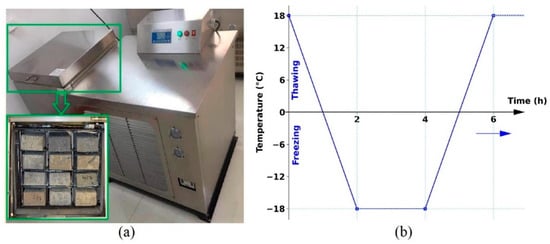
Figure 8.
Freeze–thaw testing: (a) climatic chamber; (b) schematic cycle profile.
2.2.4. Environmental Impact Assessment
A cradle-to-gate life-cycle assessment (LCA) was performed for the 20 mixtures incorporating RCAs, ISFs, RSFs, and HSFs, following ISO 14040-44:2006 and EN 15804:2012+A1. The mixtures varied in RCA replacement (0% and 25%) and fiber dosage (0%, 0.3%, 0.6%, 0.9%) as in Table 4. The system boundary covered raw material extraction and processing (cement production, aggregate production/recycling, ISF production, RSF recovery) through concrete production, excluding transport and manufacturing operations assumed identical across mixtures; this ensured a fair comparative basis. Transport was intentionally excluded because all mixtures were produced in the same laboratory using the same suppliers, batching procedures, and handling conditions. Therefore, transportation distances, fuel consumption, and loading/unloading processes would be identical for every mixture and would not influence relative environmental rankings. Including transport would introduce uniform background emissions that do not affect comparative eco-efficiency assessments, consistent with EN 15804 provisions for excluding identical processes across alternatives. The functional unit was 1 m3 of concrete.
The life-cycle inventory (LCI) quantified material/energy inputs and emissions/wastes. Environmental data for the superplasticizer were taken from an International EPD database []. Cement and background data were sourced from ELCD []; RCA data came from suppliers, on-site surveys, and the literature [,,]; ISF/RSF data were obtained from local suppliers, with RSF impacts based on Kurda et al. []. Aggregate and water data followed [,], reflecting appropriate regional and technological conditions.
The life-cycle impact assessment (LCIA) covered eight EN 15804:2012+A1 categories: global warming potential (GWP), ozone depletion (ODP), acidification (AP), eutrophication (EP), photochemical ozone creation (POCP), abiotic depletion—elements and fossil fuels (ADP-elements, ADP-fossil), and primary energy demand (renewable and non-renewable: PE-Re, PE-NRe). CML was applied for GWP, ODP, AP, EP, POCP, and ADP; cumulative energy demand (CED) was used for energy indicators. Impact factors for each raw material (Table 5 and Table 6) were multiplied by their quantities in Table 4 to obtain total impacts per 1 m3. Sensitivity analyses varied cement emissions by ±15% and RCA/fiber GWP by ±20% to address uncertainty and test robustness.

Table 5.
Baseline cradle-to-gate impacts per 1 kg of raw material (CML).

Table 6.
CED results per 1 kg of raw material: PE-NRe and PE-Re.
2.2.5. Eco-Efficiency Analysis (MCDA)
Eco-efficiency was evaluated for all 20 mixtures by integrating mechanical performance, durability, and environmental impacts within a multi-criteria decision analysis (MCDA) framework aligned with circular economy goals. Criteria included and ; durability indicators were compressive, tensile, and flexural strength retention after 300 cycles (, , ). Environmental criteria comprised GWP, AP, EP, POCP, ADP-elements, ADP-fossil, PE-NRe, and PE-Re (Section 2.2.4).
All criteria were normalized for comparability [,]. For “larger-is-better” metrics (mechanical/durability), normalization used the following:
For “smaller-is-better” metrics (environmental), the inverted form was applied:
Here, is the original value; and are the minimum and maximum for criterion j. Weights were derived via the entropy method, which assigns higher weights to more variable criteria [,]. The procedure was as follows:
(1) Probability matrix
(2) Entropy
(3) Divergence
(4) Normalized weights
with n specimens and m criteria. Weights were reported for transparency; typically, and GWP received higher weights due to their variability.
Two MCDA schemes were applied: the Weighted Sum Method (WSM) and the Technique for Order Preference by Similarity to Ideal Solution (TOPSIS). WSM scores were computed as the weighted sums of normalized values. TOPSIS rankings were based on Euclidean distances to the positive-ideal and negative-ideal solutions using the same normalized dataset and weights. Robustness was examined by re-running both methods with equal weights (1/m); close agreement with entropy-based rankings confirmed the stability of the eco-efficiency conclusions.
3. Results and Discussion
3.1. Mechanical Properties
3.1.1. Compressive Strength
Figure 9 displays the 28-day stress–strain responses; the corresponding mean compressive strength , secant modulus (), compressive toughness (), and CoV are summarized in Table 7. Both RCA content and fiber type significantly affected strength. In the N100_R0 series (0% RCA), ranged from 24.42 MPa (N100_R0_ISF0.9_RSF0) to 31.72 MPa (N100_R0_ISF0_RSF0), establishing the NA baseline. At 25% RCA (N75_R25), the plain mix decreased to 28.47 MPa—about a 10% reduction relative to N100_R0. Fiber reinforcement mitigated this loss; notably, the hybrid at 0.9% (N75_R25_ISF0.45_RSF0.45) reached 29.7 MPa, outperforming single-fiber mixes at the same RCA level (e.g., ~24.2 MPa for N75_R25_ISF0_RSF0.9).
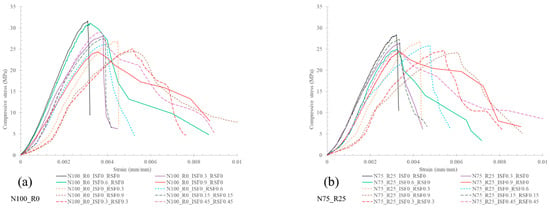
Figure 9.
Compressive stress–strain relationship: (a) N100_R0 series and (b) N75_R25 series at 28 days.

Table 7.
Compressive strength, secant modulus, and compressive toughness (cylinders, 28 days).
Trends in stiffness were consistent. The N100_R0 series showed the highest ; stiffness declined with RCA, reflecting weaker RCA ITZs []. Fibers yielded modest stiffness gains, with N75_R25_ISF0.45_RSF0.45 showing the most improvement, attributable to early-stage crack-bridging and confinement by steel fibers [,,].
Figure 9 also highlights differences in peak stress, stiffness, and post-peak behavior. N100_R0 exhibited the largest peaks and steepest slopes; N75_R25 curves were flatter, indicating a reduced stiffness with RCA. Post-peak softening was more gradual in fiber-reinforced mixes, consistent with the toughness values in Table 7. increased substantially with fiber volume, from 14.9 N/mm (N75_R25_ISF0_RSF0) to 41.7 N/mm (N75_R25_ISF0.45_RSF0.45). The latter surpassed plain, ISF0.9, and RSF0.9 at an equal RCA by 180%, 31%, and 20%, respectively. The more extended post-peak tails in HSF curves (e.g., N75_R25_ISF0.45_RSF0.45) in Figure 9b corroborate this ductility gain.
The reductions in with RCA are consistent with its higher porosity and lower density, which weaken the matrix–aggregate skeleton []. Fibers counteract this by improving energy absorption and crack control. Hybrids combine short RSFs (micro-crack-bridging) with longer ISFs (macro-crack resistance), producing a multi-scale stabilization effect and superior pull-out behavior versus single-fiber systems [,,]. At very high dosages, however, strength can drop (e.g., 0.9% ISFs yielding 24.42 MPa in N100_R0_ISF0.9_RSF0), likely due to clustering and localized weak zones []. Overall, up to 25% RCA can be substituted while maintaining adequate compressive strength and markedly increasing toughness when hybrid fibers are used, advancing circular economy aims for RCCP.
3.1.2. Splitting Tensile Strength
Figure 10 summarizes the 28-day splitting tensile strength (). Both RCA and fiber configuration influenced performance, with steel fibers, especially hybrids, providing the largest gains. Plain controls were lowest (3.15 MPa and 3.10 MPa for N100_R0 and N75_R25), with a slight decline at higher RCA due to a weaker ITZ and higher porosity [].

Figure 10.
Splitting tensile strength (MPa) and CoV (%) for RCCP: (a) N100_R0 and (b) N75_R25 at 28 days.
ISF-only mixes increased via enhanced crack-bridging: N100_R0_ISF0.9_RSF0 and N75_R25_ISF0.9_RSF0 reached 4.51 and 4.46 MPa, +43% and +44% over their plain counterparts. RSF-only additions produced moderate gains (e.g., N75_R25_ISF0_RSF0.9 = 4.34 MPa, +40%), reflecting shorter length/lower tensile strength.
Hybrids outperformed single-fiber mixes in both series; N100_R0_ISF0.45_RSF0.45 and N75_R25_ISF0.45_RSF0.45 achieved 4.54 and 4.58 MPa (≈+44% and +48%). This superiority stems from synergistic macro-/micro-crack control, long ISFs for macro-bridging and short RSFs for multidirectional micro-bridging, and improved dispersion [,]. CoVs were generally <12% for HSFs, indicating a consistent behavior, including at 25% RCA (e.g., N75_R25_ISF0.45_RSF0.45, MPa, CoV = 8.5%). These findings align with prior work on hybrid steel fiber efficacy in tensile performance and toughness, particularly with RCA [,,,].
3.1.3. Flexural Strength
Flexural behavior from 3PNBBT at 28 days, initial flexural strength , and residual strengths to are reported in Table 8. The results were sensitive to RCA and fiber strategy. Initial strengths ranged from 3.86 MPa (N75_R25_ISF0_RSF0) to 6.21 MPa (N75_R25_ISF0.45_RSF0.45). In plain mixes, raising RCA from 0% to 25% reduced by ~7% (4.14 to 3.86 MPa), consistent with the higher porosity and weaker ITZ []. Steel fibers, particularly in HSF mode and at 0.6–0.9%, substantially improved post-cracking capacity. For example, N100_R0_ISF0.45_RSF0.45 delivered the highest (6.25 MPa) and strong residuals (6.1 and 2.6 MPa for and , outperforming ISF-only (e.g., N100_R0_ISF0.9_RSF0) and RSF-only (e.g., N100_R0_ISF0_RSF0.9) counterparts at comparable dosages.

Table 8.
Flexural tensile parameters from 3PNBBT (28 days).
Figure 11 and Figure 12 present load/stress–CMOD curves, flexural toughness , and fracture energy to 3.5 mm CMOD. Plain mixes were weakest ( = 2.41–2.48 kN.mm; = 0.13 N/mm). ISF-only at 0.9% showed marked gains ( > 47 kN.mm; = ~2.5 N/mm). RSF-only performed lower, reflecting the limited macro-crack-bridging by short fibers []. HSFs gave the highest energy absorption: N100_R0_ISF0.45_RSF0.45 and N75_R25_ISF0.45_RSF0.45 reached 48.1–47.83 kN.mm, and = 2.55–2.57 N/mm. The combined long hooked-end ISFs (macro-bridging) and short RSFs (micro-control) enhanced stress redistribution across the full CMOD range [,,,]. CMOD curves for HSF display gentler post-peak decay and broader plateaus, signatures of greater ductility, whereas single-fiber mixes show sharper drops.
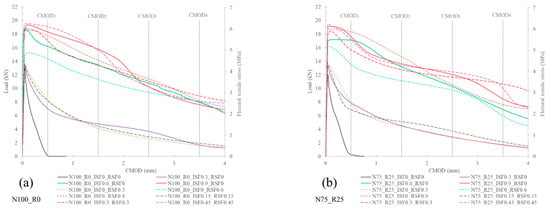
Figure 11.
Load and flexural stress vs. CMOD: (a) N100_R0 and (b) N75_R25 at 28 days.

Figure 12.
Flexural toughness/fracture energy and CoV (%) to 3.5 mm CMOD: (a) N100_R0 and (b) N75_R25 at 28 days.
In summary, HSFs substantially elevate flexural capacity and ductility, including at low RCA. While RCA reduces via matrix/ITZ effects, steel fibers, especially hybrids, offset these drawbacks. Consequently, HSF-reinforced RCCP with substantial RCA can match or exceed NA-based mechanical performance, supporting resource conservation and circularity.
3.2. Durability Performance
3.2.1. Compressive Strength Retention
The compressive strength retention after 100, 200, and 300 FTCs is shown in Figure 13 (details in Table S2). Fiber type strongly influenced the long-term capacity. Plain mixes degraded most: in N100_R0, retention fell from 85.4% (100 FTCs) to 63.8% (300 FTCs); with RCA (N75_R25_ISF0_RSF0) it reached 59.2% at 300 FTCs, consistent with higher porosity and weaker matrix–aggregate bonding accelerating frost damage [,]. Fiber reinforcement, especially hybrids, improved resistance markedly. N75_R25_ISF0.45_RSF0.45 retained 96.0%, 90.5%, and 85.75% after 100/200/300 cycles (~45% above the plain at 300 FTCs). N100_R0_ISF0.9_RSF0 showed a similar robustness (95.5%, 90.2%, 85.2%). HSFs consistently delivered the highest retentions (e.g., N75_R25_ISF0.3_RSF0.3 ≥87% at 200 FTCs and ~84% at 300 FTCs), attributable to denser fiber networks that limit permeability, restrain crack formation, and reduce internal water mobility during cycling [,]. Thus, hybrids at 0.6–0.9% with up to 25% RCA achieved durability on par with or superior to 100% NA mixes with ISF-only.

Figure 13.
Compressive strength retention after 100, 200, and 300 FTCs: (a) N100_R0; (b) N75_R25.
3.2.2. Tensile Strength Retention
Figure 14 (and Table S3) shows tensile retention under FTCs. Plain mixes again degraded, from 85.6% to 67.6% (N100_R0_ISF0_RSF0) and ~82.5% to 67.4% (N75_R25_ISF0_RSF0) by 300 cycles, driven by RCA-related porosity and weakened interfaces that accelerate cracking and moisture damage [,]. Steel fibers improved durability; at 0.9% ISF, both series maintained >96% at 100 FTCs and >85% at 300 FTCs. Hybrids outperformed single-fiber systems; N75_R25_ISF0.45_RSF0.45 retained 98.1%, 93.2%, and 89.1% at 100/200/300 cycles, about +32% vs. plain and +6% vs. RSF-only at 300 cycles. The gains reflect enhanced bridging, matrix densification, and reduced permeability from the hybrid network [,,]. Overall, 0.6–0.9% HSFs with 25% RCA preserved a tensile capacity comparable to full-NA mixes.

Figure 14.
Tensile strength retention after 100, 200, and 300 FTCs: (a) N100_R0; (b) N75_R25.
3.2.3. Flexural Strength Retention
Flexural retention across 100–300 FTCs (Figure 15; Table S4) depended on both RCA and fibers. In plain mixes, the 300-cycle retention changed little, 70.2% (N100_R0) vs. 69.8% (N75_R25), though RCA promoted micro-cracking under cycling []. After 100 FTCs, the retention was 83.58% (N100_R0) and 77.7% (N75_R25), declining to 78.6% and 74.9% at 200 FTCs. Fiber reinforcement improved retention; differences among fiber types/dosages were modest, but hybrids at 0.9% (ISF0.45_RSF0.45) were highest at 300 cycles: 84.3% (N100_R0) and 83.3% (N75_R25). ISF-only at 0.9% retained 83.1% (N100_R0) to 82.9% (N75_R25), while RSF-only ranged 82.4–81.2%. The slightly lower RSF performance likely reflects reduced macro-bridging by shorter fibers []; hybrid gains are consistent with complementary crack-bridging and improved stress redistribution []. Even with 25% RCA, HSFs tempered the declines evident in plain mixes, underscoring their robustness for cyclic environmental loading.

Figure 15.
Flexural strength retention after 100, 200, and 300 FTCs: (a) N100_R0; (b) N75_R25.
To further illustrate the combined influence of RCA and hybrid steel fibers, Figure 16 directly compares the percentage gain/loss in key mechanical and freeze–thaw durability indicators for mixtures with and without 25% RCA. The plain mixture (N100_R0) experienced substantial reductions when 25% RCA was introduced (e.g., −10.2% in and −7.3% in CSR). In contrast, the hybrid mixture (N75_R25_ISF0.45_RSF0.45) exhibited negligible reductions or slight improvements in all parameters, including CSR, TSR, and FSR. This confirms that hybrid fibers almost entirely compensate for RCA-induced losses and effectively stabilize both strength and freeze–thaw durability.

Figure 16.
Percentage gain/loss due to 25% RCA for mechanical and durability indicators comparing plain and hybrid mixtures (ISF0.45_RSF0.45).
3.3. Environmental Impacts
A cradle-to-gate LCA (CML baseline and CED) was conducted for 1 m3 of concrete across nine impact categories (Figure 17, Figure 18, Figure 19, Figure 20, Figure 21, Figure 22, Figure 23, Figure 24 and Figure 25; numerical data in Tables S5 and S6). Given its centrality to climate targets [], GWP trends are highlighted first. GWP decreased with RCA (Figure 17): for plain RCCP, it decreased from 337.4 kg CO2-eq (N100_R0) to 331.5 kg CO2-eq (N75_R25), reflecting the lower embodied carbon of RCA versus NA [,]. At 0.9% fiber, ISF-only showed the highest GWP (e.g., 421.7 kg CO2-eq for N75_R25_ISF0.9_RSF0) due to energy-intensive production, whereas RSF-only was lower (e.g., 354.3 kg CO2-eq for N75_R25_ISF0_RSF0.9, −16%), confirming RSF’s advantage []. Within HSF at 25% RCA, increasing the total fiber from 0.3% to 0.9% raised GWP 350.4 to 388 kg CO2-eq (+11%), still below ISF-only at equal dosage, while delivering comparable/superior performance.

Figure 17.
GWP for 1 m3 of RCCP: (a) N100_R0; (b) N75_R25.

Figure 18.
ODP for 1 m3 of RCCP: (a) N100_R0; (b) N75_R25.

Figure 19.
AP for 1 m3 of RCCP: (a) N100_R0; (b) N75_R25.

Figure 20.
EP for 1 m3 of RCCP: (a) N100_R0; (b) N75_R25.

Figure 21.
POCP for 1 m3 of RCCP: (a) N100_R0; (b) N75_R25.

Figure 22.
ADP-elements for 1 m3 of RCCP: (a) N100_R0; (b) N75_R25.

Figure 23.
ADP-fossil for 1 m3 of RCCP: (a) N100_R0; (b) N75_R25).

Figure 24.
PE-NRe for 1 m3 of RCCP: (a) N100_R0; (b) N75_R25).

Figure 25.
PE-Re for 1 m3 of RCCP: (a) N100_R0; (b) N75_R25).
ODP remained nearly constant with 25% RCA (Figure 18; ~1.52 × 10−5 kg CFC-11-eq), indicating a limited sensitivity to aggregate type; cement/admixtures dominated. RSF-based mixes recorded relatively low ODP (e.g., N75_R25_ISF0_RSF0.9: 1.58 × 10−5), while ISF-only mixes were higher (e.g., N75_R25_ISF0.9_RSF0: 2.04 × 10−5), with HSFs being intermediate—patterns consistent with refrigerant/solvent use in steel production chains.
AP (kg SO2-eq) decreased with RCA (Figure 19): 0.95 to 0.91 kg for plain mixes (0% to 25% RCA). ISF-only had higher AP (up to 1.14 kg) due to fuel/emissions in steel manufacturing; RSF and HSF were lower (e.g., 1.0 kg for N75_R25_ISF0.45_RSF0.45), supporting the findings that recycled steel reduces acidification [,].
EP followed similar reductions with RCA (Figure 20): 0.13 to 0.12 kg PO4-eq (plain). ISF-only peaked near 0.16 kg; RSFs/HSFs were lower (0.14–0.15 kg). Lower fiber dosages further reduced EP, especially within HSFs (0.13 kg at 0.3% vs. 0.15 kg at 0.9%), indicating a viable dosage–impact trade-off.
POCP exhibited the same ordering (Figure 21). Plain mixes decreased from 0.066 to 0.064 kg ethene-eq with RCA. At 0.9% fiber in N75_R25, RSF ≈ 0.067 kg, ISF ≈ 0.098 kg, and HSF ≈ 0.083 kg, consistent with lower volatile emissions in RSF recovery. Moderate fiber contents (0.3–0.6%) kept POCP low, advantageous for urban air-quality goals [,].
ADP-elements (kg Sb-eq) was governed by aggregates and steel (Figure 22). With 25% RCA, RSF mixes reached up to 1.73 × 10−5 at 0.9%, likely reflecting additional energy and preprocessing in recovery lines []. Increased RCA had a stronger effect on lowering ADP-elements in plain mixes (0.60 × 10−5 at 25% RCA), while HSFs lay between RSF-only and plain, offering a balanced profile.
ADP-fossil (MJ) mirrored GWP (Figure 23). For plain mixes, it rose slightly with RCA (1180.5 to 1193.6 MJ). ISF-only at 0.9% reached ~2227 MJ, whereas RSF-only stayed <1532 MJ, confirming the fossil energy advantage of recycled steel. HSFs at 0.9% remained moderate (e.g., 1879.6 MJ for N75_R25_ISF0.45_RSF0.45).
Primary energy, non-renewable (PE-NRe), was dominated by cement (≈76.6% in N100_R0_ISF0_RSF0), followed by CG (≈21.2%) (Figure 24). ISFs notably increased PE-NRe (≈27% share in N100_R0_ISF0.9_RSF0), aligning with their influence on GWP/POCP/ADP-fossil. Replacing 50% ISFs with RSFs and 25% CG with RCA (N75_R25_ISF0.45_RSF0.45) lowered the total PE-NRe by ~15%, evidencing the energy-saving benefits of RSFs and RCA.
Primary energy, renewable (PE-Re), was also driven by cement (~60% share). In N100_R0_ISF0.9_RSF0, SP and ISFs contributed ~20% and ~19%, respectively (Figure 25). Replacing ISF0.9 with RSF0.9 reduced the ISF contribution from ~19% to ~2%. RCA and natural fines had a negligible effect on PE-Re. N75_R25_ISF0.45_RSF0.45 consumed up to ~10% less PE-Re than N100_R0_ISF0.9_RSF0, confirming the benefits of partial ISF → RSF substitution and RCA use.
Figure 26 illustrates the sensitivity of total GWP under cement (±15%) and RCA/steel fiber (±20%) emission variations. The sensitivity analysis revealed that cement-related emissions dominated the total GWP across all RCCP mixtures. Varying cement emission factors by ±15% produced changes of approximately ±46 kg CO2/m3 for every mixture, confirming cement as the primary driver of environmental impact. In contrast, RCA and steel fiber emission variations (±20%) resulted in far smaller shifts (typically ±1–14 kg CO2/m3), reflecting their limited contribution to the overall footprint. Mixtures with higher ISF dosages showed a slightly greater sensitivity due to the higher embodied GWP of industrial fibers, while RSF-based mixtures exhibited modest responses owing to their lower GWP values. Because the dominant cement effect applies uniformly to all mixtures, the relative ranking of mixtures remained stable under all tested scenarios, demonstrating the robustness of the environmental conclusions.
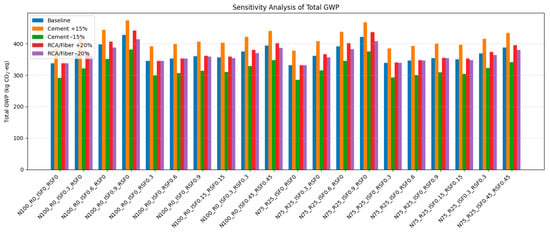
Figure 26.
Sensitivity of total GWP for all RCCP mixtures under cement (±15%) and RCA/steel fiber (±20%) emission variations.
3.4. Eco-Efficiency Ranking
To synthesize performance and impact, MCDA using WSM and TOPSIS was applied (Table 9), and Figure 27 contrasts the two most eco-efficient mixtures against a conventional reference (N100_R0_ISF0.9_RSF0; same total steel dosage, 0.9%, 100% NA). The mixture N75_R25_ISF0.45_RSF0.45 ranked first in both WSM (0.72) and TOPSIS (0.64), balancing high mechanical indices ( = 4.58 MPa; = 6.21 MPa), excellent freeze–thaw retention (CSR/TSR/FSR > 83% at 300 cycles), and moderate impacts (GWP = 388 kg CO2-eq; ADP-Fossil = 1879.6 MJ), corresponding to a 50% higher eco-efficiency based on WSM (0.72 vs. 0.48) and a 30% improvement based on TOPSIS (0.64 vs. 0.49) relative to the reference mixture.

Table 9.
Eco-efficiency ranking of RCCP mixtures by WSM and TOPSIS.
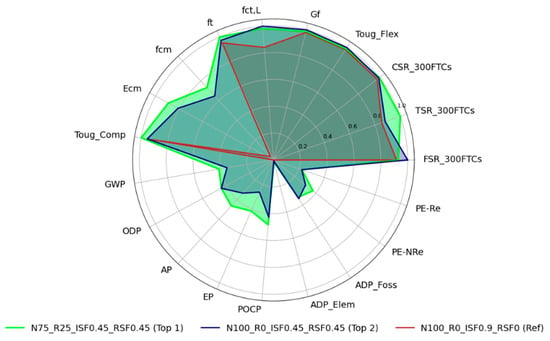
Figure 27.
Normalized comparison of mechanical, durability (300 FTCs), and environmental metrics for the two top eco-efficient mixtures vs. control (N100_R0_ISF0.9_RSF0), based on WSM/TOPSIS.
By contrast, the conventional reference N100_R0_ISF0.9_RSF0 ranked lower (WSM = 0.48; TOPSIS = 0.49). Despite its inferior elastic and compressive performance ( = 29.18 GPa; = 24.4 MPa), it also carried the highest GWP (427.6 kg CO2-eq), ADP-fossil (2214.2 MJ), and PE-NRe (2925.7 MJ), illustrating the environmental penalty of exclusive ISFs and virgin aggregates. Figure 27 shows that both hybrid mixes deliver more balanced profiles, confirming the efficacy of moderate hybrid fiber dosages combined with RCA in advancing circular, resource-efficient RCCP.
In summary, the leading eco-efficient mixes, especially N75_R25_ISF0.45_RSF0.45, offer a compelling blend of durability, structural performance, and reduced environmental burden. Hybrid fiber configurations in RCA-rich concretes achieve the most sustainable outcomes without sacrificing reliability, reinforcing hybrid fiber, RCA-based RCCP as a robust pathway for low-carbon, circular pavement infrastructure. Overall, the combined results show that mixtures with hybrid steel fibers (HSFs) effectively balance mechanical performance, freeze–thaw durability, and environmental efficiency. While RCA incorporation reduces strength and durability, the synergistic action of ISFs + RSFs mitigates these losses, leading to a higher strength retention under freeze–thaw exposure. From the LCA results, mixtures containing RSF and RCA exhibit a lower GWP, ADP-fossil, and PE-NRe due to the lower embodied energy of recycled fibers. The MCDA ranking confirms that mixtures with low RCA content (25%) and hybrid fibers achieve the best compromise between mechanical response, durability, and environmental impact, demonstrating the importance of evaluating all three domains together rather than in isolation.
4. Conclusions
This study evaluated the combined influence of recycled concrete aggregate (RCA) and steel fiber systems, industrial (ISF), recycled (RSF), and hybrid ISF/RSF (HSF), on the mechanical performance, freeze–thaw durability, and cradle-to-gate environmental impacts of roller-compacted concrete pavement (RCCP). Twenty mixtures incorporating 25% RCA and 0–0.9% fiber volume were examined using an integrated framework combining mechanical and durability testing with life-cycle assessment (LCA) and multi-criteria decision analysis (MCDA; Weighted Sum Method and TOPSIS).
Increasing RCA content reduced compressive, tensile, and flexural strengths, consistent with the higher porosity and weaker interfacial transition zone of RCA. However, hybrid fiber reinforcement at 0.9% effectively compensated for these reductions. At 25% RCA, the HSF-reinforced mixture achieved a compressive strength comparable to the natural aggregate control (29.7 MPa vs. 31.7 MPa), while substantially improving toughness (up to +265%) and splitting tensile strength (up to +45%). The freeze–thaw performance also improved: after 300 cycles, HSF mixtures retained ~85.7% of compressive strength, ~89.1% of tensile strength, and more than 83% of flexural strength, outperforming plain and single-fiber mixtures by up to ~20%.
Environmental results demonstrated clear benefits from substituting natural aggregates and industrial steel fibers with RCAs and RSFs. The most balanced mixture, N75_R25_ISF0.45_RSF0.45, reduced the global warming potential (GWP) by ~10% and non-renewable primary energy demand (PE-NRe) by ~15% relative to its ISF-only counterpart. MCDA ranked this mixture as the most eco-efficient, showing a ~50% improvement in WSM score (0.72 vs. 0.48) and ~30% improvement in TOPSIS score (0.64 vs. 0.49) compared with the conventional reference mixture (N100_R0_ISF0.9_RSF0).
Several limitations should be acknowledged. All experiments were conducted under controlled laboratory conditions, meaning the effects of traffic loading, climatic variation, and long-term maintenance were not captured. The study also did not incorporate life-cycle cost modelling or full pavement service-life assessment. Future work should include field-scale trials to validate long-term performance, integrate combined mechanical–environmental–economic evaluation, and explore predictive modelling and optimization techniques for designing eco-efficient RCCP.
In summary, combining hybrid steel fibers with partial RCA replacement provides an effective pathway toward cleaner production and circularity in RCCP. This strategy reduces the reliance on virgin materials, enhances mechanical and durability performance, and decreases embodied environmental impacts, supporting next-generation low-carbon pavement solutions.
Supplementary Materials
The following supporting information can be downloaded at https://www.mdpi.com/article/10.3390/infrastructures10120321/s1. Table S1: Detailed mix proportions for all RCCP mixtures; Table S2: Compressive strength retention of RCCP specimens exposed to 100, 200, and 300 FTCs; Table S3: Tensile strength retention of RCCP specimens exposed to 100, 200, and 300 FTCs; Table S4: Flexural strength retention of RCCP specimens exposed to 100, 200, and 300 FTCs; Table S5: Baseline results of the CML method for producing 1 m3 of RCCP mixtures; Table S6: Cumulative energy demand (CED) results for the production of 1 m3 of RCCP mixtures.
Author Contributions
Conceptualization, O.H., M.S., N.A. and M.B.; methodology, O.H., M.S., N.A. and M.B.; software, O.H., M.S., N.A. and M.B.; validation, O.H., M.S., N.A. and M.B.; formal analysis, O.H., M.S., N.A. and M.B.; investigation, O.H., M.S., N.A. and M.B.; resources, O.H., M.S., N.A. and M.B.; data curation, O.H., M.S., N.A. and M.B.; writing-original draft preparation, O.H., M.S., N.A. and M.B.; writing-review and editing, O.H. visualization, O.H., M.S., N.A. and M.B.; supervision, O.H.; project administration, O.H.; funding acquisition, O.H., M.S., N.A. and M.B. All authors have read and agreed to the published version of the manuscript.
Funding
This research was financially supported by the Fundação para a Ciência e Tecnologia (FCT) through the MIT Portugal Program (MPP) Grant 2023 (Ref. PRT/BD/154665/2023). Additional institutional support was provided to the research units CERIS (Ref. UIDB/04625/2020, DOI: 10.54499/UIDB/04625/2020), ISISE (Ref. UIDB/04029/2020, DOI: 10.54499/UIDB/04029/2020), and ARISE (Ref. LA/P/0112/2020). The third author also acknowledges individual FCT support under grant 2021.05328.BD.
Data Availability Statement
The original contributions presented in the study are included in the article, further inquiries can be directed to the corresponding authors.
Acknowledgments
The authors gratefully acknowledge the project “Methodologies and Tools for BIM-Based Calculation of Dynamic Life Cycle Assessment towards Net Zero Emission Buildings”, funded by FCT under the MIT Portugal Program (MPP), developed within the Doctoral Program in Civil Engineering at Instituto Superior Técnico, Universidade de Lisboa. The authors also acknowledge the institutional support of ISISE – Institute for Sustainability and Innovation in Structural Engineering, University of Minho.
Conflicts of Interest
The authors declare no conflicts of interest.
Abbreviations
The abbreviations used in this manuscript are as follows:
| ADP-Elem | Abiotic depletion of elements |
| ADP-fossil | Abiotic depletion of fossil fuels |
| AP | Acidification potential |
| Cem | Cement |
| CG | Crushed granite (coarse aggregate) |
| CMOD | Crack-mouth opening displacement |
| CSR_300FTCs | Compressive strength retention after 300 freeze–thaw cycles |
| Ecm | Secant modulus of elasticity |
| EP | Eutrophication |
| fcm | Uniaxial compressive strength |
| fct,L | Initial flexural tensile strength |
| FRC | Fiber-reinforced concrete |
| FSR_300FTCs | Flexural strength retention after 300 freeze–thaw cycles |
| ft | Splitting tensile strength |
| FTCs | Freeze–thaw cycles |
| Gf | Fracture energy |
| GHG | Greenhouse gas |
| GWP | Global warming potential |
| HSF | Hybrid ISF/RSF fibers |
| ISF | Industrial steel fiber |
| ITZ | Interfacial transition zone |
| LCA | Life-cycle assessment |
| LCI | Life-cycle inventory |
| MCDA | Multi-criteria decision analysis |
| MDD | Maximum dry density |
| NA | Natural aggregate |
| ODP | Ozone depletion |
| OMC | Optimum moisture content |
| OPC | Ordinary Portland cement |
| PE_NRe | Non-renewable energy |
| PE_Re | Renewable energy |
| POCP | Photochemical ozone creation potential |
| RCA | Recycled concrete aggregate |
| RCCP | Roller-compacted concrete pavement |
| RS | River sand (fine aggregate) |
| RSF | Recycled steel fiber |
| SP | Superplasticizer |
| TOPSIS | Technique for Order of Preference by Similarity to Ideal Solution |
| Toug_Comp | Compressive toughness |
| Toug_Flex | Flexural toughness |
| TSR_300FTCs | Tensile strength retention after 300 freeze–thaw cycles |
| Wat | Water |
| WSM | Weighted Sum Method |
| 3PNBBT | Three-point notched beam bending tests |
References
- Razi, N.; Ansari, R. A prediction-based model to optimize construction programs: Considering time, cost, energy consumption, and CO2 emissions trade-off. J. Clean. Prod. 2024, 445, 141164. [Google Scholar] [CrossRef]
- Min, J.; Yan, G.; Abed, A.M.; Elattar, S.; Khadimallah, M.A.; Jan, A.; Ali, H.E. The effect of carbon dioxide emissions on the building energy efficiency. Fuel 2022, 326, 124842. [Google Scholar] [CrossRef]
- Salles, A.; Salati, M.; Bragança, L. Using City Information Modelling to Evaluate Urban Circularity Through Sustainability Indicators. In Creating a Roadmap Towards Circularity in the Built Environment; Springer Nature: Cham, Switzerland, 2023; pp. 385–394. [Google Scholar]
- Hasheminezhad, A.; King, D.; Ceylan, H.; Kim, S. Comparative life cycle assessment of natural and recycled aggregate concrete: A review. Sci. Total. Environ. 2024, 950, 175310. [Google Scholar] [CrossRef]
- Shmlls, M.; Abed, M.; Fořt, J.; Horvath, T.; Bozsaky, D. Towards closed-loop concrete recycling: Life cycle assessment and multi-criteria analysis. J. Clean. Prod. 2023, 410, 137179. [Google Scholar] [CrossRef]
- Azimi, N.; Schollbach, K.; Oliveira, D.V.; Lourenço, P.B. Effect of acidic environment exposure on mechanical properties of TRM composites. Constr. Build. Mater. 2024, 438, 137142. [Google Scholar] [CrossRef]
- Tang, Y.; Xiao, J.; Liu, Q.; Xia, B.; Singh, A.; Lv, Z.; Song, W. Natural gravel-recycled aggregate concrete applied in rural highway pavement: Material properties and life cycle assessment. J. Clean. Prod. 2022, 334, 130219. [Google Scholar] [CrossRef]
- Abedi, M.; Hassanshahi, O.; Rashiddel, A.; Ashtari, H.; Meddah, M.S.; Dias, D.; Arjomand, M.; Choong, K.K. A sustainable cementitious composite reinforced with natural fibers: An experimental and numerical study. Constr. Build. Mater. 2023, 378, 131093. [Google Scholar] [CrossRef]
- Keleş, Ö.F.; Bayrak, O.Ü.; Bayata, H.F. Experimental investigation on mechanical properties of sustainable roller compacted concrete pavement (RCCP) containing waste rubbers as alternative aggregates. Constr. Build. Mater. 2024, 424, 135930. [Google Scholar] [CrossRef]
- Debbarma, S.; Ransinchung, G.D. Achieving sustainability in roller compacted concrete pavement mixes using reclaimed asphalt pavement aggregates—State of the art review. J. Clean. Prod. 2021, 287, 125078. [Google Scholar] [CrossRef]
- de Bortoli, A. Understanding the environmental impacts of virgin aggregates: Critical literature review and primary comprehensive life cycle assessments. J. Clean. Prod. 2023, 415, 137629. [Google Scholar] [CrossRef]
- Sheikh, E.; Mousavi, S.R.; Afshoon, I. Producing green Roller Compacted Concrete (RCC) using fine copper slag aggregates. J. Clean. Prod. 2022, 368, 133005. [Google Scholar] [CrossRef]
- Aghayan, I.; Khafajeh, R.; Shamsaei, M. Life cycle assessment, mechanical properties, and durability of roller compacted concrete pavement containing recycled waste materials. Int. J. Pavement Res. Technol. 2021, 14, 595–606. [Google Scholar] [CrossRef]
- Xing, W.; Tam, V.W.; Le, K.N.; Hao, J.L.; Wang, J. Life cycle assessment of sustainable concrete with recycled aggregate and supplementary cementitious materials. Resour. Conserv. Recycl. 2023, 193, 106947. [Google Scholar] [CrossRef]
- de Andrade Salgado, F.; de Andrade Silva, F. Recycled aggregates from construction and demolition waste towards an application on structural concrete: A review. J. Build. Eng. 2022, 52, 104452. [Google Scholar] [CrossRef]
- Özçelikci, E.; Oskay, A.; Bayer, I.R.; Şahmaran, M. Eco-hybrid cement-based building insulation materials as a circular economy solution to construction and demolition waste. Cem. Concr. Compos. 2023, 141, 105149. [Google Scholar] [CrossRef]
- Bai, W.; Song, Z.; Yuan, C.; Guan, J.; Xie, C.; Huang, H.; Ma, Y. Study on mechanical properties and damage mechanism of recycled concrete containing silica fume in freeze–thaw environment. Constr. Build. Mater. 2023, 375, 130872. [Google Scholar] [CrossRef]
- Yang, T.; Gong, L.; Jin, C.; Qin, J.; Dang, D.; Cui, X. Study on the pore characteristics and ITZ properties of recycled aggregate concrete by desert sand subjecting to salt freeze-thaw environments. J. Build. Eng. 2025, 108, 112918. [Google Scholar] [CrossRef]
- Zhang, W.; Liu, H.; Liu, C. Impact of rice husk ash on the mechanical characteristics and freeze–thaw resistance of recycled aggregate concrete. Appl. Sci. 2022, 12, 12238. [Google Scholar] [CrossRef]
- Gao, D.; Luo, F.; Yan, Y.; Tang, J.; Yang, L. Experimental investigation on the flexural performance and damage process of steel fiber reinforced recycled coarse aggregate concrete. Structures 2023, 51, 1205–1218. [Google Scholar] [CrossRef]
- Guo, S.; Ding, Y.; Zhang, X.; Xu, P.; Bao, J.; Zou, C. Tensile properties of steel fiber reinforced recycled concrete under bending and uniaxial tensile tests. J. Build. Eng. 2024, 96, 110467. [Google Scholar] [CrossRef]
- Bakhshi, M.; Valente, I.B.; Ramezansefat, H.; Barros, J.A.O. Evaluation of the inertia force in compressive impact loading on steel fiber-reinforced concrete. In Proceedings of the RILEM-Fib International Symposium on Fibre Reinforced Concrete, Valencia, Spain, 20–22 September 2021; Springer: Berlin/Heidelberg, Germany, 2021; pp. 277–288. [Google Scholar]
- Barros, J.; Costelha, H.; Bento, D.; Brites, N.; Luís, R.; Patrício, H.; Cunha, V.; Bento, L.; Miranda, T.; Coelho, P.; et al. A multidisciplinary engineering-based approach for tunnelling strengthening with a new fibre reinforced shotcrete technology. Tunn. Undergr. Space Technol. 2024, 147, 105707. [Google Scholar]
- Wang, Z.; Hu, H.; Papastergiou, P.; Angelakopoulos, H.; Guadagnini, M.; Pilakoutas, K. Effect of fibre length on the mechanical properties of SFRC using recycled Steel fibres. Constr. Build. Mater. 2024, 415, 134890. [Google Scholar] [CrossRef]
- Zhang, P.; Wang, C.; Guo, J.; Wu, J.; Zhang, C. Production of sustainable steel fiber-reinforced rubberized concrete with enhanced mechanical properties: A state-of-the-art review. J. Build. Eng. 2024, 91, 109735. [Google Scholar]
- Mahboob, A.; Hassanshahi, O.; Safi, M.; Majid, T.A. Experimental investigation of eco-friendly fiber-reinforced concrete using recycled and natural fibers, integrated with recycled aggregates. Adv. Compos. Mater. 2024, 33, 1101–1130. [Google Scholar]
- Abdolpour, H.; Niewiadomski, P.; Kwiecień, A.; Tekieli, M.; Sadowski, Ł. Fundamental understanding of the mechanical and post- cracking behaviour of ultra-high performance mortar with recycled steel fibers. Constr. Build. Mater. 2023, 374, 130918. [Google Scholar] [CrossRef]
- Roshan, N.; Ghalehnovi, M.; Pakzad, S.S. Recycled steel fiber for fiber reinforced concrete production: Fresh and hardened properties, cost, and ecological assessments. J. Build. Pathol. Rehabil. 2023, 8, 24. [Google Scholar]
- Gu, L.; Liu, Y.; Zeng, J.; Zhang, Z.; Pham, P.N.; Liu, C.; Zhuge, Y. The synergistic effects of fibres on mechanical properties of recycled aggregate concrete: A comprehensive review. Constr. Build. Mater. 2024, 436, 137011. [Google Scholar] [CrossRef]
- Zhong, H.; Chen, M.; Zhang, M. Effect of hybrid industrial and recycled steel fibres on static and dynamic mechanical properties of ultra-high performance concrete. Constr. Build. Mater. 2023, 370, 130691. [Google Scholar] [CrossRef]
- Mehmandari, T.A.; Shokouhian, M.; Josheghan, M.Z.; Mirjafari, S.A.; Fahimifar, A.; Armaghani, D.J.; Tee, K.F. Flexural properties of fiber-reinforced concrete using hybrid recycled steel fibers and manufactured steel fibers. J. Build. Eng. 2024, 98, 111069. [Google Scholar] [CrossRef]
- Dharek, M.S.; M, M.; S, B.; Vengala, J.; Tangadagi, R.B. Performance evaluation of hybrid fiber reinforced concrete on engineering properties and life cycle assessment: A sustainable approach. J. Clean. Prod. 2024, 458, 142498. [Google Scholar] [CrossRef]
- Hassanshahi, O.; Kameli, S.; Mohammadpour, R.; Bakhshi, M.; Mahboob, A. Experimental Investigation of Sustainable Roller-Compacted Concrete Pavement (RCCP) Reinforced with Natural Fibers: Mechanical Performance, Durability, and Environmental Impacts. Int. J. Pavement Res. Technol. 2025, 1–24. [Google Scholar] [CrossRef]
- Zhu, P.; Chen, X.; Liu, H.; Wang, Z.; Chen, C.; Li, H. Recycling of waste recycled aggregate concrete in freeze-thaw environment and emergy analysis of concrete recycling system. J. Build. Eng. 2024, 96, 110377. [Google Scholar] [CrossRef]
- Zhang, Y.; Sun, X.; Zhu, X.; Xiao, J. Multi-criteria optimization of concrete mixes incorporating cenosphere waste and multi-minerals. J. Clean. Prod. 2022, 367, 133102. [Google Scholar] [CrossRef]
- Rashid, K.; Rehman, M.U.; de Brito, J.; Ghafoor, H. Multi-criteria optimization of recycled aggregate concrete mixes. J. Clean. Prod. 2020, 276, 124316. [Google Scholar] [CrossRef]
- Negrin, I.; Kripka, M.; Yepes, V. Multi-criteria optimization for sustainability-based design of reinforced concrete frame buildings. J. Clean. Prod. 2023, 425, 139115. [Google Scholar] [CrossRef]
- Lu, L. Optimal replacement ratio of recycled concrete aggregate balancing mechanical performance with sustainability: A review. Buildings 2024, 14, 2204. [Google Scholar] [CrossRef]
- Alibeigibeni, A.; Stochino, F.; Zucca, M.; Gayarre, F.L. Enhancing concrete sustainability: A critical review of the performance of recycled concrete aggregates (RCAs) in structural concrete. Buildings 2025, 15, 1361. [Google Scholar] [CrossRef]
- Hoseini, S.O.; Sohrabi, M.R.; Mousavi, S.R.; Ghasemi, M. Studying the rheological features, mechanical properties and flexural toughness of the WSFRSCC by varying the coarse aggregate volume. Structures 2023, 57, 105115. [Google Scholar] [CrossRef]
- EFCA. Environmental Product Declaration (EPD) Report. Concrete Admixtures–Plasticisers and Superplasticisers; European Federation of Concrete Admixtures Associations Ltd. (EFCA): Brussels, Belgium, 2015. [Google Scholar]
- EN 197-1; European Reference Life Cycle Database of the Joint Research Center, Version 3.2: Portland Cement (CEM I). CEMBUREAU Production Mix, at Plant, CEMBUREAU Technology Mix. European Committee for Standardization: Brussels, Belgium, 2015.
- Park, W.-J.; Kim, T.; Roh, S.; Kim, R. Analysis of life cycle environmental impact of recycled aggregate. Appl. Sci. 2019, 9, 1021. [Google Scholar] [CrossRef]
- Kurda, R.; Silvestre, J.D.; de Brito, J. Life cycle assessment of concrete made with high volume of recycled concrete aggregates and fly ash. Resour. Conserv. Recycl. 2018, 139, 407–417. [Google Scholar] [CrossRef]
- Braga, A.M.; Silvestre, J.D.; de Brito, J. Compared environmental and economic impact from cradle to gate of concrete with natural and recycled coarse aggregates. J. Clean. Prod. 2017, 162, 529–543. [Google Scholar] [CrossRef]
- Abed, M.; Shmlls, M. Analysis of three generations of recycled concrete: An approach using LCA and weighted sum model. Mater. Today Proc. 2023. [Google Scholar] [CrossRef]
- Kareem, M.; Ajadi, E.; Fadipe, O.; Ishola, K.; Olawuyi, O.; Ayanlere, S.; Olatoyan, O.; Adeosun, J.; Adefajo, A.; Oyewo, A.; et al. Sustainability-driven application of waste steel and tyre rubber fibres as reinforcement in concrete: An optimization study using response surface methodology. Next Mater. 2025, 7, 100345. [Google Scholar] [CrossRef]
- Zong, S.; Liu, Z.; Li, S.; Lu, Y.; Zheng, A. Stress-strain behaviour of steel-fibre-reinforced recycled aggregate concrete under axial tension. J. Clean. Prod. 2021, 278, 123248. [Google Scholar] [CrossRef]
- Peen, W.Y.; Keong, C.K. Behaviour of hollow circular section with multiple perforations under compression, flexure and torsion. Lat. Am. J. Solids Struct. 2019, 16, e169. [Google Scholar] [CrossRef]
- Li, J.; Zhang, J.; Ni, S.; Liu, L.; Walubita, L.F. Mechanical performance and environmental impacts of self-compacting concrete with recycled demolished concrete blocks. J. Clean. Prod. 2021, 293, 126129. [Google Scholar] [CrossRef]
- Yang, Y.; Zhou, Q.; Deng, Y.; Lin, J. Reinforcement effects of multi-scale hybrid fiber on flexural and fracture behaviors of ultra-low-weight foamed cement-based composites. Cem. Concr. Compos. 2022, 128, 104422. [Google Scholar]
- Ramkumar, K.B.; Kannan Rajkumar, P.R. Impact of hybrid steel fibres on fresh and mechanical properties of Self-compacting concrete. Case Stud. Constr. Mater. 2022, 17, e01274. [Google Scholar] [CrossRef]
- Mahboob, A.; Hassanshahi, O.; Hakimi, A.; Safi, M. Evaluating the performance of hollow core slabs (HCS)-concrete and simplifying their implementation. Recent Prog. Mater. 2023, 5, 1–15. [Google Scholar] [CrossRef]
- Wu, Z.; Shi, C.; Khayat, K.H. Investigation of mechanical properties and shrinkage of ultra-high performance concrete: Influence of steel fiber content and shape. Compos. Part B Eng. 2019, 174, 107021. [Google Scholar] [CrossRef]
- Yin, D.; Zhang, M.; Xiong, B.; Zhang, S. Study on the physical and mechanical properties of concrete interfacial transition zones (ITZ) with consideration of positional effects. Constr. Build. Mater. 2025, 486, 141985. [Google Scholar] [CrossRef]
- Htet, P.; Chen, W.; Hao, H.; Shaikh, F. Influence of micro basalt and recycled macro polypropylene hybrid fibre on physical and mechanical properties of recycled aggregate concrete. J. Build. Eng. 2023, 76, 107083. [Google Scholar] [CrossRef]
- Cui, K.; Xu, L.; Tao, T.; Huang, L.; Li, J.; Hong, J.; Li, H.; Chi, Y. Mechanical behavior of multiscale hybrid fiber reinforced recycled aggregate concrete subject to uniaxial compression. J. Build. Eng. 2023, 71, 106504. [Google Scholar] [CrossRef]
- Abedi, M.; Sanivada, U.K.; Mirian, S.A.; Fangueiro, R. A self-sensing and self-heating planar braided composite for smart civil infrastructures reinforcement. Constr. Build. Mater. 2023, 387, 131617. [Google Scholar] [CrossRef]
- Zia, A.; Zhang, P.; Holly, I. Effectiveness of hybrid discarded tire/Industrial steel fibers for improving the sustainability of concrete structures. Constr. Build. Mater. 2023, 378, 131226. [Google Scholar] [CrossRef]
- Hassanshahi, O.; Taksiah, A.; Tze Liang, L.; Yousefi, A. Seismic performance of the typical RC beam–column joint subjected to repeated earthquakes. In Proceedings of the International Conference of Global Network for Innovative Technology and Awam International Conference in Civil Engineering (IGNITE-AICCE’17), Penang, Malaysia, 8–9 August 2017; AIP Conference Proceedings. AIP Publishing: Melville, NY, USA, 2017; Volume 1892. [Google Scholar] [CrossRef]
- Wang, Z.; Liang, X.; Wan, S.; Cao, Z.; Weng, S.; Wu, K. Experimental and theoretical investigation on axial tensile behavior of ultra-high performance concrete (UHPC) with recycled steel fibers from waste tires. Constr. Build. Mater. 2024, 456, 139300. [Google Scholar] [CrossRef]
- Abedi, M.; Hassanshahi, O.; Barros, J.A.; Correia, A.G.; Fangueiro, R. Three-dimensional braided composites as innovative smart structural reinforcements. Compos. Struct. 2022, 297, 115912. [Google Scholar] [CrossRef]
- Yuan, C.; Qu, S.; Bai, W.; Guan, J.; Xie, Y. Study on the mechanical properties and mesoscopic damage mechanism of recycled aggregate concrete under different dynamic strain rates after freeze-thaw cycles. Case Stud. Constr. Mater. 2025, 22, e04182. [Google Scholar]
- Liu, K.; Fu, K.; Sang, Y.; Yang, Y.; Zou, C.; Xie, T.; Zhao, X. Frost resistance of recycled aggregate concrete: A critical review. J. Build. Eng. 2024, 90, 109450. [Google Scholar] [CrossRef]
- Li, Y.; Qi, M.; Ji, S. Study on chloride penetration resistance of hybrid fiber-reinforced concrete in winter construction. Mater. Struct. 2025, 58, 27. [Google Scholar] [CrossRef]
- Shao, R.; Wu, C.; Li, J.; Liu, Z. Development of sustainable steel fibre-reinforced dry ultra-high performance concrete (DUHPC). J. Clean. Prod. 2022, 337, 130507. [Google Scholar] [CrossRef]
- Zhong, R.; Ai, X.; Pan, M.; Yao, Y.; Cheng, Z.; Peng, X.; Wang, J.; Zhou, W. Durability of micro-cracked UHPC subjected to coupled freeze-thaw and chloride salt attacks. Cem. Concr. Compos. 2024, 148, 105471. [Google Scholar] [CrossRef]
- Han, X.; Ding, N.; Chen, A.; Wang, Z.; Xu, Y.; Feng, L.; Ji, Y.; Li, K.; Jing, J.; Sun, S.; et al. Experimental study on freeze-thaw failure of concrete incorporating waste tire crumb rubber and analytical evaluation of frost resistance. Constr. Build. Mater. 2024, 439, 137356. [Google Scholar] [CrossRef]
- El Ouni, M.H.; Shah, S.H.A.; Ali, A.; Muhammad, S.; Mahmood, M.S.; Ali, B.; Marzouki, R.; Raza, A. Mechanical performance, water and chloride permeability of hybrid steel-polypropylene fiber-reinforced recycled aggregate concrete. Case Stud. Constr. Mater. 2022, 16, e00831. [Google Scholar] [CrossRef]
- Hassanshahi, O.; Jorge, M.; Sena-Cruz, J.; Correia, L.; Leite, C.; Hasan, T.; Correia, J.R.; Garrido, M.; Cabral-Fonseca, S. Durability of GFRP composites produced by pultrusion under thermal environments. Procedia Struct. Integr. 2024, 64, 81–88. [Google Scholar] [CrossRef]
- Lu, D.; Wang, D.; Wang, Y.; Zhong, J. Nano-engineering the interfacial transition zone between recycled concrete aggregates and fresh paste with graphene oxide. Constr. Build. Mater. 2023, 384, 131244. [Google Scholar] [CrossRef]
- Bao, X.; Li, Y.; Chen, X.; Yang, H.; Cui, H. Investigation on the flexural behaviour and crack propagation of hybrid steel fibre reinforced concrete with a low fibre content for tunnel structures. Constr. Build. Mater. 2024, 417, 135253. [Google Scholar] [CrossRef]
- Wang, X.; Liu, Y.; Yoo, D.-Y. Combined corrosion and inclination effects on pullout behavior of various steel fibers under wet-dry cycle deterioration. Cem. Concr. Compos. 2023, 142, 105229. [Google Scholar] [CrossRef]
- Salati, M.; Costa, A.A.; Silvestre, J.D. A Comprehensive Review of Dynamic Life Cycle Assessment for Buildings: Exploring Key Processes and Methodologies. Sustainability 2024, 17, 159. [Google Scholar] [CrossRef]
- Ma, X.; Hu, H.; Luo, Y.; Yao, W.; Wei, Y.; She, A. A carbon footprint assessment for usage of recycled aggregate and supplementary cementitious materials for sustainable concrete: A life-cycle perspective in China. J. Clean. Prod. 2025, 490, 144772. [Google Scholar] [CrossRef]
- Li, L.; Li, S.; Li, W.; Xiao, H.; Xu, K.; Yang, J. Mechanical properties of soil reinforced by fiber and alkaline-activated rice husk ash, and rainfall erosion model tests. Sci. Total. Environ. 2025, 958, 178099. [Google Scholar] [CrossRef]
- Hafez, H.; Malchiodi, B.; Tošić, N.; Drewniok, M.; Purnell, P.; de la Fuente, A. Decarbonization potential of steel fibre-reinforced limestone calcined clay cement concrete one-way slabs. Constr. Build. Mater. 2024, 435, 136847. [Google Scholar] [CrossRef]
- Dezhampanah, S.; Nikbin, I.; Charkhtab, S.; Fakhimi, F.; Bazkiaei, S.M.; Mohebbi, R. Environmental performance and durability of concrete incorporating waste tire rubber and steel fiber subjected to acid attack. J. Clean. Prod. 2020, 268, 122216. [Google Scholar] [CrossRef]
- Kumari, S.; Walia, R. Life cycle assessment of sustainable concrete by utilizing groundnut husk ash in concrete. Mater. Today Proc. 2022, 49, 1910–1915. [Google Scholar] [CrossRef]
- Sadhukhan, J.; Sen, S.; Gadkari, S. The mathematics of life cycle sustainability assessment. J. Clean. Prod. 2021, 309, 127457. [Google Scholar] [CrossRef]
- Huang, W.; Wang, H. Comprehensive assessment of engineering and environmental attributes of geopolymer pervious concrete with natural and recycled aggregate. J. Clean. Prod. 2024, 468, 143138. [Google Scholar] [CrossRef]
- Biswas, W.K.; Zhang, X.; Matters, C.; Maboud, M. Techno-Eco-Efficiency Assessment of Using Recycled Steel Fibre in Concrete. Sustainability 2024, 16, 3717. [Google Scholar] [CrossRef]
Disclaimer/Publisher’s Note: The statements, opinions and data contained in all publications are solely those of the individual author(s) and contributor(s) and not of MDPI and/or the editor(s). MDPI and/or the editor(s) disclaim responsibility for any injury to people or property resulting from any ideas, methods, instructions or products referred to in the content. |
© 2025 by the authors. Licensee MDPI, Basel, Switzerland. This article is an open access article distributed under the terms and conditions of the Creative Commons Attribution (CC BY) license (https://creativecommons.org/licenses/by/4.0/).